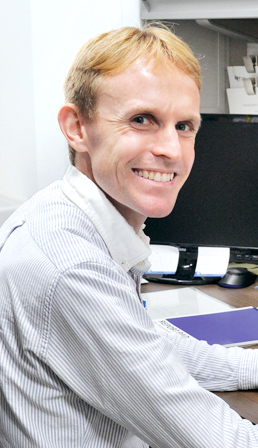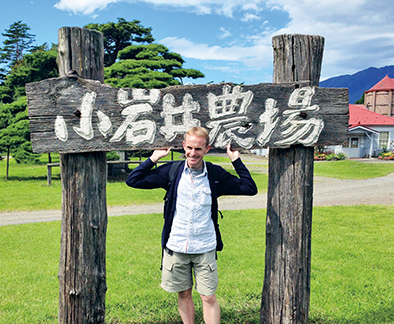Towards ultra-thin wires using mathematical models
A central processing unit (CPU), the brain of a computer, has eight billion transistors arranged on a five centimeter square substrate. Each transistor is about 20 nm, almost five thousandth the diameter of a human hair. Such minuscule and sensitive electronics require nanofabrication techniques to assemble and align atoms and molecules. Daniel Packwood has successfully developed such synthesis methods by utilizing theoretical chemistry that explain intricate molecular actions with mathematical models.
Junior Associate Professor
Daniel Packwood
Daniel Packwood
In contrast to his mastery of mathematics today, Packwood did not excel academically before entering the university. He barely passed the college entrance exam in New Zealand. “I struggled in mathematics, and I gave up learning Japanese - I had only chosen it because I was a big Super Nintendo fan [laughs].” Friends’ remarks motivated young Packwood. “Friends of mine said that math and chemistry would be too difficult for me. It was just a casual comment, but I felt insulted at that time for my scores were actually low.” Packwood studied hard to prove his friends wrong and awakened to the appeal of chemistry and mathematics.

Born in 1985 in Christchurch, New Zealand. Completed his PhD in chemistry at the College of Science of the University of Canterbury in 2010 and came to Japan as a chemistry postdoc of the Kyoto University Graduate School of Science. Has remained in his present position since 2016, after working for the Advanced Institute for Materials Research (AIMR) at Tohoku University.
Charms of iCeMS: High-level research and flexible cross-disciplinary approaches

Packwood originally sought a research position in the West, but a conference in Japan opened his eyes to the high level of research here. “I immediately contacted a laboratory at Kyoto University.” After spending one and a half years in Kyoto, he moved to the Advanced Institute for Materials Research (AIMR) at Tohoku University, another World Premier International Research Center. Since April 2016, he has been a member of iCeMS.
Packwood feels that the unpartitioned laboratories of iCeMS permit cross-disciplinary communications. “Sometimes my fellow researchers ask for my comments on fresh experimental data. New ideas occur to me one after another as I talk with them.”
Next-generation wires as fine as one hundred-thousandth the size of a human hair
Packwood focuses on the study of “molecular self-assembly,” a phenomenon seen in the growth of snow crystals or double-helical DNA, where molecules naturally organize into functional structures. He aims to apply this mechanism to nanotechnology. “If molecules lie on a straight line and become organized, we should be able to produce a wire as fine as one hundred-thousandth the size of a human hair. This will definitely contribute to the miniaturization of electronic devices.” Utilizing predictions from an original mathematical model, Packwood has successfully identified the types of molecules predisposed to form straight lines, along with ideal temperature conditions for alignment. His achievements promise to lessen the need for time-consuming and costly experiments, a rewarding step forward.
While a few of his findings still require validation with experimental data, Packwood is quite optimistic. “iCeMS has an environment for collaboration, so I can readily demonstrate my theory through experiments. I am sure my study will bear more and more fruits from now. I hope to perfect a real product while being here at iCeMS.”

Developing mathematical formulas in his head
Pen, paper, and a computer are all Packwood needs to conduct basic research. He has filled hundreds notebooks since college. “I can write formulas in my head these days. Equations are like good friends to me. I memorize their every feature, just like I remember names, faces, voices.” Sometimes he even starts calculations in his head. “Thinking about research all the time is part of being a researcher. It’s the same as monks, who are monks all the time.”
Packwood says that he felt more stress about his research in his twenties because of then-insufficient knowledge and experience to identify research targets. “But now, in my thirties, I have a broader range of methodologies to utilize, and can find solutions more quickly than before. And my research outcomes make my work all the more interesting. Research involves continual hardships with days of repeated failures, but once it bears fruit, it is very satisfying!”
Cooperation: Kyoto Tsushinsha Press
*This article was originally published in the newsletter “iCeMS Our World Your Future vol.3”. All the information on this page, including the researcher’s affiliation, is current at the time of publication.